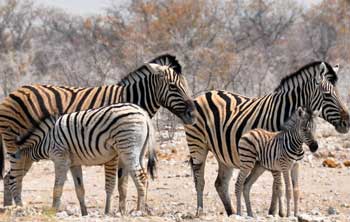
Zebra Hybridization project gets boost from Nedbank Fund

Government scientists are attempting to obtain crucial answers around the potential crossbreeding and survival of two Zebra species in the Etosha National Park with funding assistance from the Nedbank Go Green Fund.
The study which launched in March last year, will continue until the end of November this year.
Project leader Kenneth /Uiseb, the deputy director for wildlife monitoring and research at the Ministry of Environment and Tourism (MET), explained that the aim of the Etosha Zebra Hybridization Project is to conduct detailed research in whether hybridization is taking place between the two zebra species and what factors drive the phenomenon in the park.
The country is home to two species of zebra, including the Hartmann’s mountain zebra, which is near endemic to Namibia, and the Plain Burchell’s zebra, both of which occur in Etosha National Park, though the Burchell’s zebra is at much greater numbers.
/Uiseb highlighted that Etosha National Park is a protected area, “meant to offer protection to both species, ensure both exist in their natural form and contribute to ecosystem functioning.”
The study will help with this goal, by unearthing what the overall impact of possible hybridization is on the near endemic, and low-density Hartmann’s zebra, among other crucial questions.
He said that it is “imperative for the conservation of both species to understand hybridization, its level and scale between the two species.”
In the Etosha National Park, the Hartmann’s mountain zebra are mainly restricted to the western periphery of the park while the plain zebra are widespread, and an indelible part of most visitors’ experience when they visit.
Yet their ecological ranges overlap, and the study is taking a close look at what happens when two similar species intermingle.
“Hartmann’s mountain zebra and plains zebra are of similar body size, feed on grasses and further have similar digestive systems. They also share common predators,” /Uiseb noted in a project progress report to the Nedbank Go Green Fund.
He further explained that, “it is of great ecological interest” to understand the home range and habitat use of the two species, the type and quality of plants they feed on and whether the “interaction between the two species potentially lead to observable conservation problems such as hybridization.”
While this study is a first of its kind, and no in-depth research has been conducted to confirm potential hybridization, / Uiseb noted that some evidence points to it being likely.
“Hybridization is thought to be more prevalent in western Etosha were the range of the two species overlap,” /Uiseb explained that to date it is “not well understood” how such a close co-existence between similar species has “no observed detrimental effect”, and the study hopes to improve understanding.
Angus Middleton, director of the Namibia Nature Foundation, the Nedbank Go Green Fund’s technical partner, said the reason for the assistance in funding to the zebra project is that it will “help address an important management question for the Ministry of Environment and Tourism in Etosha.”
Moreover, the project outcomes will be applicable all along the escarpment where the two zebra species occur and potentially mix.
Middleton explained that Namibia, which is home to the vast majority of Hartmann’s mountain zebra, “has a global responsibility to ensure that they are well managed and this project helps uphold that responsibility.”
/Uiseb highlighted the importance of independent and local funding, explaining that it can be difficult to access international funding because Namibia is regarded as an upper middle-income country.
“It is important that local companies fill this gap and invest in better conservation of the wildlife, as wildlife is an important economic asset that contributes significantly to our gross domestic product.”
He said the Nedbank Go Green Fund has helped significantly with fieldwork costs associated with the collection of biological samples, and has also assisted with the acquisition of important veterinary equipment.












































